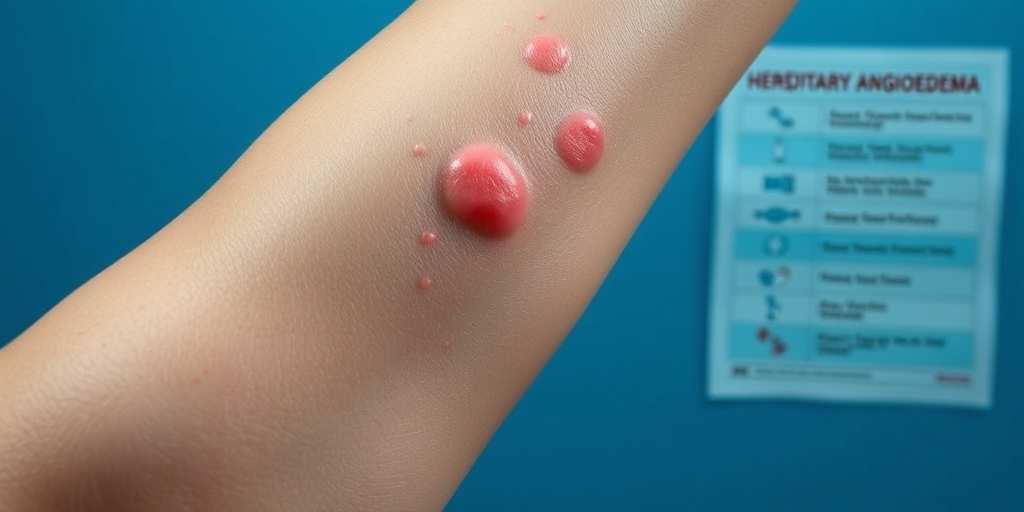What Is Hereditary Angioedema?
Hereditary Angioedema (HAE) is a rare genetic disorder characterized by recurrent episodes of severe swelling (angioedema) in various parts of the body, including the face, extremities, gastrointestinal tract, and airway. This condition is caused by a deficiency or dysfunction of a protein called C1 inhibitor, which plays a crucial role in regulating the complement and contact systems of the blood. When this protein is deficient or not functioning properly, it leads to uncontrolled inflammation and swelling.
Types of Hereditary Angioedema
There are three main types of hereditary angioedema, each with distinct causes and characteristics:
- Type 1: This is the most common form, accounting for about 85% of cases. It is caused by a deficiency of C1 inhibitor.
- Type 2: This type is less common and results from a dysfunctional C1 inhibitor protein, leading to similar symptoms as Type 1.
- Type 3: This rare form occurs in individuals with normal levels of C1 inhibitor and is often associated with mutations in the factor XII gene. It can also be triggered by hormonal changes, such as those occurring during menstruation or pregnancy.
Understanding the type of hereditary angioedema is essential for effective management and treatment. If you suspect you or a loved one may have HAE, consulting a healthcare professional is crucial for accurate diagnosis and personalized care.
Causes of Hereditary Angioedema
Hereditary angioedema is inherited in an autosomal dominant pattern, meaning that only one copy of the mutated gene from an affected parent can cause the disorder in their offspring. This genetic link is why family history plays a significant role in the diagnosis of HAE. If someone in your family has been diagnosed with hereditary angioedema, it’s essential to discuss this with your healthcare provider, as genetic testing may be recommended.
Hereditary Angioedema Symptoms
The symptoms of hereditary angioedema can vary significantly from person to person, both in terms of frequency and severity. The hallmark of this condition is the sudden onset of swelling, which can occur without any apparent trigger. Here are some common symptoms associated with HAE:
Common Symptoms
- Swelling: This can occur in various areas, including the face, hands, feet, and gastrointestinal tract. Swelling in the airway can be particularly dangerous and requires immediate medical attention.
- Pain: Abdominal swelling can lead to severe pain, mimicking other conditions like appendicitis.
- Difficulty Breathing: Swelling in the throat or airway can cause breathing difficulties, which is a medical emergency.
- Skin Changes: Some individuals may experience a rash or changes in skin color during an episode.
Triggers of Hereditary Angioedema Episodes
While episodes can occur spontaneously, certain factors may trigger or exacerbate symptoms, including:
- Stress: Emotional or physical stress can lead to an increase in episodes.
- Injury: Trauma to the body can trigger swelling.
- Hormonal Changes: For some women, hormonal fluctuations during menstruation or pregnancy can provoke episodes.
- Infections: Illnesses can also trigger swelling episodes.
When to Seek Medical Attention
If you or someone you know experiences symptoms of hereditary angioedema, especially swelling in the throat or difficulty breathing, it is vital to seek emergency medical care immediately. Early intervention can be life-saving.
For those living with hereditary angioedema, understanding the condition and its symptoms is crucial for effective management. Resources like Yesil Health AI (yesilhealth.com) can provide valuable, evidence-based information to help you navigate your health journey.
In conclusion, hereditary angioedema is a complex condition that requires awareness and understanding. By recognizing the symptoms and knowing when to seek help, individuals can better manage their health and improve their quality of life. 🌟

Causes of Hereditary Angioedema
Hereditary Angioedema (HAE) is a rare genetic disorder characterized by recurrent episodes of severe swelling (angioedema) in various parts of the body, including the face, extremities, gastrointestinal tract, and airway. Understanding the causes of hereditary angioedema is crucial for effective management and treatment. Let’s delve into the underlying factors that contribute to this condition.
Genetic Mutations
The primary cause of hereditary angioedema is genetic mutations that affect the production of a protein called C1 inhibitor (C1-INH). This protein plays a vital role in regulating the complement and contact systems of the immune response. There are three main types of hereditary angioedema, each linked to different genetic mutations:
- Type 1: This is the most common form, caused by a deficiency of C1-INH due to mutations in the SERPING1 gene.
- Type 2: Similar to Type 1, but characterized by normal or elevated levels of C1-INH that are dysfunctional due to mutations in the same gene.
- Type 3: This rare form is not linked to C1-INH deficiency and is often associated with mutations in the F12 gene, which affects the production of factor XII, a protein involved in blood clotting.
Triggers of Angioedema Episodes
While the underlying cause of hereditary angioedema is genetic, certain triggers can precipitate episodes of swelling. These triggers may include:
- Physical trauma: Injuries or surgical procedures can lead to swelling.
- Emotional stress: High-stress situations may trigger an episode.
- Hormonal changes: Fluctuations in hormones, particularly during menstruation or pregnancy, can exacerbate symptoms.
- Infections: Illnesses can sometimes trigger angioedema episodes.
- Medications: Certain drugs, especially those that affect blood pressure, can provoke swelling.
Risk Factors for Hereditary Angioedema
Understanding the risk factors for hereditary angioedema can help individuals identify their likelihood of developing the condition and manage it effectively. Here are some key risk factors to consider:
Family History
Since hereditary angioedema is an inherited condition, having a family history of HAE significantly increases the risk. If a parent has the disorder, there is a 50% chance that their child will inherit the genetic mutation responsible for the condition. This familial link underscores the importance of genetic counseling for affected families.
Gender and Age
While both men and women can be affected by hereditary angioedema, some studies suggest that women may experience more frequent episodes, particularly during hormonal changes such as menstruation or pregnancy. The onset of symptoms typically occurs in childhood or early adulthood, although it can manifest at any age.
Type of Hereditary Angioedema
The type of hereditary angioedema also influences risk factors. For instance, individuals with Type 1 and Type 2 HAE are more likely to experience severe symptoms due to the deficiency or dysfunction of C1-INH. In contrast, Type 3 HAE may present differently and is often associated with other conditions, such as estrogen receptor mutations.
Environmental Factors
Environmental factors can also play a role in the frequency and severity of angioedema episodes. For example, exposure to allergens, extreme temperatures, or high altitudes may trigger symptoms in susceptible individuals. Understanding these environmental triggers can help patients manage their condition more effectively.
In summary, hereditary angioedema is primarily caused by genetic mutations affecting C1-INH production, with various triggers that can lead to episodes of swelling. Recognizing the risk factors associated with this condition is essential for early diagnosis and effective management. If you suspect you or a family member may have hereditary angioedema, consulting a healthcare professional for proper evaluation and testing is crucial. 🩺

Diagnosis of Hereditary Angioedema
Diagnosing Hereditary Angioedema (HAE) can be a complex process, primarily because its symptoms can mimic those of other conditions. HAE is characterized by recurrent episodes of severe swelling, often affecting the face, extremities, gastrointestinal tract, and airway. Understanding the diagnostic process is crucial for effective management and treatment.
Recognizing Symptoms
The first step in diagnosing HAE is recognizing its symptoms. Common signs include:
- Swelling: Sudden and severe swelling of the face, hands, feet, and gastrointestinal tract.
- Pain: Abdominal pain due to swelling in the intestines.
- Breathing difficulties: Swelling in the throat can lead to life-threatening airway obstruction.
- Recurrence: Symptoms often recur without any apparent trigger.
Family History and Genetic Testing
Since HAE is a genetic condition, a thorough family history is essential. If a family member has been diagnosed with HAE, it increases the likelihood of a diagnosis. Genetic testing can confirm the presence of mutations in the C1 inhibitor gene, which is responsible for the condition. This test can help differentiate between the types of HAE:
- Type 1: Low levels of C1 inhibitor.
- Type 2: Normal or elevated levels of dysfunctional C1 inhibitor.
- Type 3: Normal C1 inhibitor levels, often seen in women and may not have a clear genetic link.
Laboratory Tests
In addition to genetic testing, several laboratory tests can aid in diagnosing HAE:
- C4 levels: Low levels of complement component 4 (C4) during an attack can indicate HAE.
- C1 inhibitor levels: Measuring the quantity and function of C1 inhibitor can help confirm the diagnosis.
- Other complement tests: These may be performed to rule out other complement-related disorders.
Consultation with Specialists
Consulting with a specialist, such as an allergist or immunologist, is often necessary for a definitive diagnosis. They can interpret test results and provide insights into the best management strategies. Early diagnosis is crucial, as it can significantly improve the quality of life for those affected by HAE.
Hereditary Angioedema Treatment Options
Once diagnosed, managing Hereditary Angioedema effectively is essential to minimize the frequency and severity of attacks. Treatment options vary based on the type of HAE and the individual’s specific needs.
Acute Treatment Options
During an acute attack, immediate treatment is vital. Options include:
- Intravenous C1 inhibitor replacement: This is the most effective treatment for acute attacks, especially in Type 1 and Type 2 HAE.
- Berotralstat: An oral medication that can help prevent attacks by inhibiting the production of bradykinin, a substance that causes swelling.
- Fresh frozen plasma: This can be administered in emergency situations to provide C1 inhibitor.
Prophylactic Treatment Options
For individuals experiencing frequent attacks, prophylactic treatment may be recommended to prevent episodes:
- Long-term C1 inhibitor therapy: Regular infusions can help maintain adequate levels of C1 inhibitor in the blood.
- Androgens: Medications like danazol can increase C1 inhibitor levels but may have side effects.
- Newer therapies: Emerging treatments, such as monoclonal antibodies targeting bradykinin, are being studied and may offer additional options in the future.
Managing Triggers
Identifying and managing potential triggers is also a crucial part of treatment. Common triggers include:
- Stress: Emotional stress can precipitate attacks.
- Injury: Physical trauma may trigger swelling.
- Hormonal changes: Menstrual cycles can influence the frequency of attacks in women.
By understanding and managing these triggers, individuals with HAE can take proactive steps to reduce the likelihood of attacks.
In conclusion, while Hereditary Angioedema can be a challenging condition to manage, advancements in treatment options and a better understanding of the disease can significantly improve the quality of life for those affected. Regular consultations with healthcare providers and adherence to treatment plans are essential for effective management. 🌟

Living with Hereditary Angioedema
Living with Hereditary Angioedema (HAE) can be a challenging journey, but understanding the condition and its implications can empower individuals to manage their symptoms effectively. HAE is a genetic disorder characterized by recurrent episodes of severe swelling, often affecting the face, extremities, gastrointestinal tract, and airway. These episodes can be painful and, in some cases, life-threatening.
Understanding the Symptoms
Recognizing the symptoms of HAE is crucial for timely intervention. Common symptoms include:
- Swelling: This can occur in various parts of the body, including the hands, feet, abdomen, and throat.
- Pain: Swelling episodes are often accompanied by significant pain and discomfort.
- Gastrointestinal Issues: Some individuals may experience nausea, vomiting, or abdominal pain during an attack.
- Breathing Difficulties: Swelling in the throat can lead to serious breathing problems, requiring immediate medical attention.
Episodes can be triggered by various factors, including stress, trauma, hormonal changes, and certain medications. Keeping a symptom diary can help identify personal triggers and patterns, allowing for better management of the condition.
Diagnosis and Treatment Options
Diagnosing HAE typically involves a thorough medical history, physical examination, and specific blood tests to measure levels of C1 inhibitor, a protein that helps regulate blood plasma. The ICD-10 code for Hereditary Angioedema is D84.1, which is essential for insurance and medical records.
Treatment for HAE focuses on managing symptoms and preventing attacks. Options include:
- Prophylactic Treatment: Regular medication to prevent swelling episodes, such as C1 inhibitor replacement therapy.
- On-Demand Treatment: Medications like bradykinin receptor antagonists or C1 inhibitors can be administered during an attack to reduce swelling.
- Emergency Care: Individuals with HAE should have an emergency plan in place, including access to medications and a clear understanding of when to seek medical help.
Hereditary Angioedema and Lifestyle Changes
Making lifestyle changes can significantly improve the quality of life for those living with Hereditary Angioedema. While the condition is genetic and cannot be cured, adopting certain habits can help manage symptoms and reduce the frequency of attacks.
Dietary Adjustments
Diet plays a crucial role in managing HAE. Some individuals may find that certain foods trigger their symptoms. Keeping a food diary can help identify these triggers. Here are some dietary tips:
- Avoid Processed Foods: These often contain additives that may trigger swelling.
- Stay Hydrated: Drinking plenty of water can help maintain overall health and may reduce the severity of attacks.
- Limit Salt Intake: High sodium levels can lead to fluid retention, potentially exacerbating swelling.
Stress Management
Stress is a known trigger for HAE attacks. Incorporating stress management techniques into daily life can be beneficial. Consider the following:
- Meditation and Mindfulness: Practicing mindfulness can help reduce stress levels and improve emotional well-being.
- Regular Exercise: Engaging in moderate physical activity can help alleviate stress and improve overall health.
- Support Groups: Connecting with others who have HAE can provide emotional support and practical advice.
Regular Medical Check-ups
Regular visits to a healthcare provider are essential for managing HAE effectively. These check-ups can help monitor the condition, adjust treatment plans, and address any new symptoms or concerns. It’s also important to stay informed about the latest research and treatment options available for HAE.
Living with Hereditary Angioedema requires a proactive approach to health and wellness. By understanding the condition, recognizing symptoms, and making informed lifestyle choices, individuals can lead fulfilling lives while managing their health effectively. 🌟

Frequently Asked Questions about Hereditary Angioedema
What is Hereditary Angioedema?
Hereditary Angioedema (HAE) is a genetic condition characterized by recurrent episodes of severe swelling (angioedema) in various parts of the body, including the face, extremities, gastrointestinal tract, and airway. These episodes can be painful and potentially life-threatening, especially if they affect breathing.
What are the symptoms of Hereditary Angioedema?
The symptoms of Hereditary Angioedema typically include:
- Swelling of the face, hands, feet, and gastrointestinal tract
- Abdominal pain due to swelling in the intestines
- Difficulty breathing if swelling occurs in the throat
- Episodes that can last from a few hours to several days
How is Hereditary Angioedema diagnosed?
Diagnosis of Hereditary Angioedema usually involves a combination of medical history, physical examination, and specific blood tests to measure levels of C1 inhibitor protein. Genetic testing may also be conducted to confirm the diagnosis.
What causes Hereditary Angioedema?
Hereditary Angioedema is caused by mutations in the genes responsible for producing the C1 inhibitor protein, which helps regulate blood vessel permeability. There are different types of HAE, including:
- Type 1: Low levels of C1 inhibitor
- Type 2: Dysfunctional C1 inhibitor
- Type 3: Normal C1 inhibitor levels but still presents with symptoms
What are the treatment options for Hereditary Angioedema?
Treatment for Hereditary Angioedema focuses on managing symptoms and preventing attacks. Options include:
- Prophylactic medications to prevent attacks
- On-demand treatments to reduce swelling during an episode
- Emergency care for severe attacks, especially those affecting breathing
Is there a specific test for Hereditary Angioedema?
Yes, there are specific tests for Hereditary Angioedema, including:
- Blood tests to measure C1 inhibitor levels
- Genetic testing to identify mutations associated with HAE
What is the ICD-10 code for Hereditary Angioedema?
The ICD-10 code for Hereditary Angioedema is D84.1. This code is used for billing and documentation purposes in healthcare settings.
Can lifestyle changes help manage Hereditary Angioedema?
While there is no cure for Hereditary Angioedema, certain lifestyle changes may help manage symptoms. These include:
- Avoiding known triggers that may provoke an attack
- Keeping emergency medications accessible
- Staying informed about the condition and treatment options
Where can I find support for Hereditary Angioedema?
Support for individuals with Hereditary Angioedema can be found through various organizations and online communities. These resources can provide valuable information, emotional support, and connections with others facing similar challenges.
Conclusion
If you have further questions about Hereditary Angioedema, it is important to consult with a healthcare professional who can provide personalized advice and treatment options. Remember, you are not alone in this journey! 🌟




